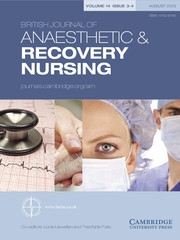No CrossRef data available.
Article contents
Diffusion Hypoxia
Published online by Cambridge University Press: 25 February 2009
Abstract
The aim of this study was to see if we could improve our practice in theatres for the benefit of the patient thus preventing diffusion hypoxia. When a patient continues to breathe from an anaesthetic circuit at the end of anaesthesia, there is a risk of delayed recovery, both by rebreathing and by the presence of anaesthetic vapour emerging from the tubes and other components of the anaesthetic equipment. It has been recommended that nitrous oxide be discontinued early in the recovery period, to monitor the patient during the first elimination phase. As hyperventilation does not influence the elimination of nitrous oxide largely, but increases the risk of subsequent hypoventilation during transport to the recovery room, hyperventilation should be avoided. It is also recommended that oxygen therapy should be used, during transport from theatre to the recovery room, regardless of the duration of nitrous oxide anaesthesia. There has proven to be a risk of Diffusion Hypoxia for at least 30 minutes after discontinuation of nitrous oxide administration in the presence of hypoventilation. The practitioner should always be cautious with heavy smokers, as they present a much greater risk of respiratory problems, and careful observation is needed for the first 5 minutes of breathing room air. Diffusion Hypoxia has proven to be avoided by administration of oxygen for 10 minutes from cessation of nitrous oxide anaesthesia.
- Type
- Research Article
- Information
- Copyright
- Copyright © British Association of Anaesthetic and Recovery Nursing 2002


